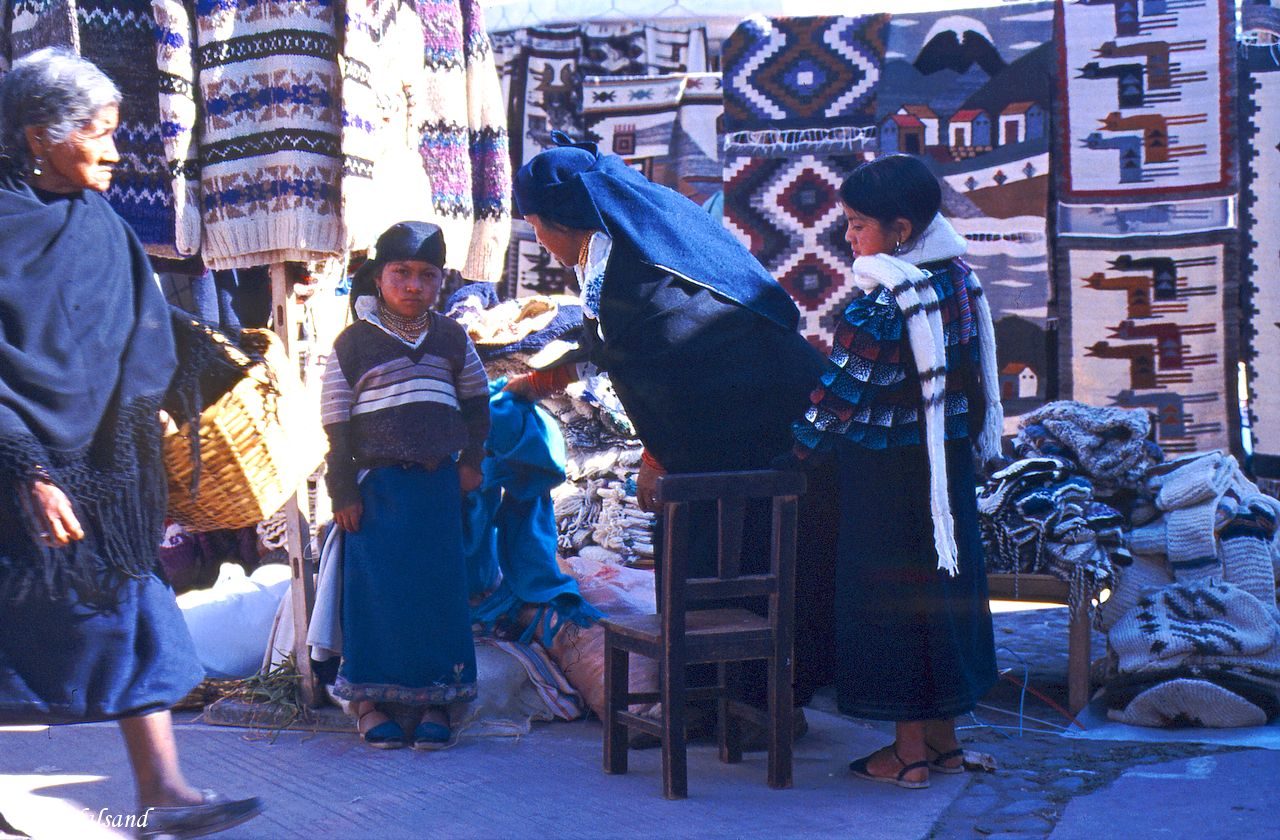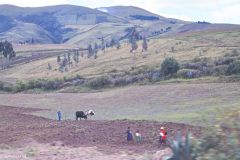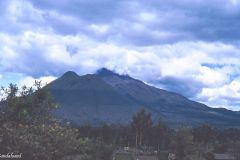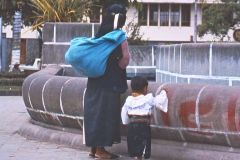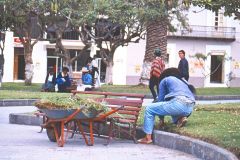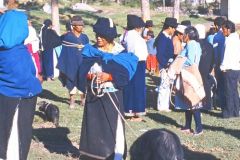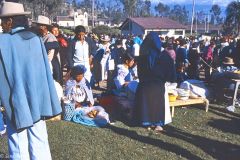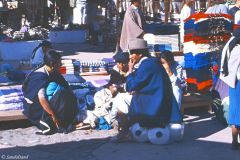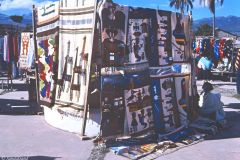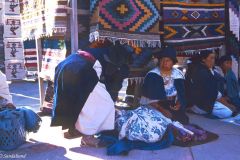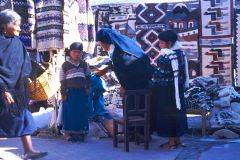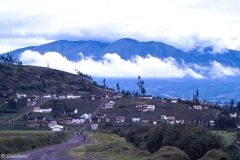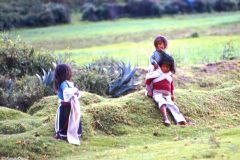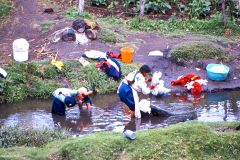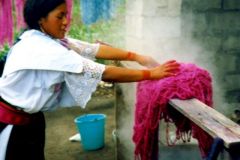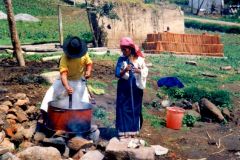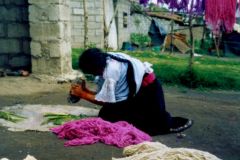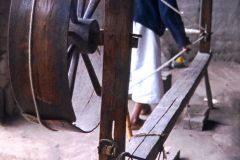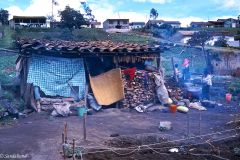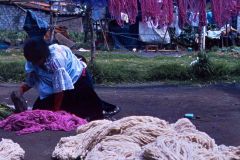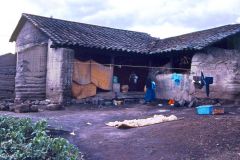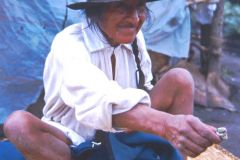This is my story from the world’s most famous Amerindian market town, Otavalo, and a very interesting guided trip to the villages around.
This article is part of a travelogue from of a five month journey in 1987-1988 to several countries in South America: Brazil, Peru, Ecuador, Bolivia, Chile.
Friday 13.11.1987, Quito – Otavalo
Otavalo has a famous Indian market on Saturdays. As the guidebook advices us to go early on the Friday to get a hotel and be ready for the market from the start, we took a taxi to Terminal del Norte (200 sucres, 0.7 USD). According to the girl at the tourist office buses for Otavalo leave every 20 minutes.
We had no opportunity to verify that because a bus was leaving right away. On the 2 hour bus trip (115 sucres, 0.4 USD) we saw some great scenery, including a volcano with a cloud on the summit.
The first recommended hotel was full but we found:
- Residencial San Sebastian. Expensive by local standards, 1500 sucres (5.4 USD) for a double bed, perfectly clean, soft wall-to-wall carpet and hot (!) shower morning and evening is fantastic. Green plants in the bathroom.
.
A tourist office provided us with a town map and managed to sell us a full day tour on Sunday. For 3.5 dollars we would be introduced to whatever there is to see and know about the life and death of the Otavalo Indians. We’ll see.
There are exciting traditional Indian costumes around, on both men and women. The men have long braided hair down their back and the women have pretty faces. But they do not like cameras.
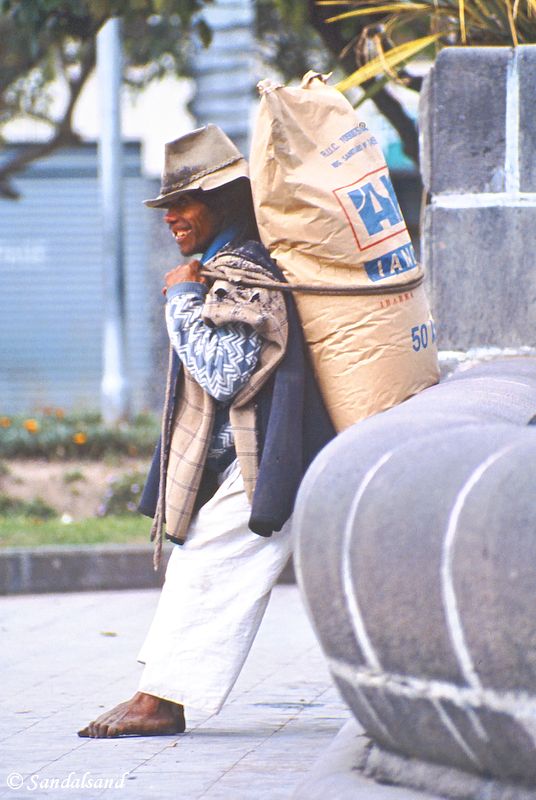
Hard work for Otavalo indians. The more they were carrying the shorter they were.
We had an excellent dinner in restaurant recommended by the South American Handbook. I chose one of their most expensive courses, prawns, costing less than a dollar. It was incredibly cheap and good. The beer is average – it’s called Pilsener.
Saturday 14.11.1987, Otavalo
This was Market day in Otavalo. We got up early and were off at seven. We first went to the livestock marked and photographed the Indians, and then we had breakfast and continued in the clothes marked shooting more Indians. Bo went crazy and shot an entire roll of film.
The clothes market was somewhat disappointing. The selection was good and the Indian sellers were colourful, but tourists made up the bulk of customers. And there were many of them. Later the bus loads from Quito arrived and emptied guides with herds of sheep in numbers. At that time we went home and washed some clothes and bags. (Otavalo is well worth a visit despite that.)
Letter to my family
I spent some hours writing this letter home
Otavalo, Ecuador, 14th of November 1987
Hello mother,
The letter I sent home a few days ago was too short, despite all. I read through your letter once more and found that it’s worth sending another one to give satisfactory comments. Besides I forgot to enclose the page my girlfriend wrote. Thirdly I haven’t got so much to do right now.
We have just been to an Indian market north of Quito: many colourful and exciting Indians, their goods (animals, groceries and textiles) as well. Even though we wittingly went out very early in the morning there were already many tourists on the spot. On the poncho market there were almost more tourists than locals. We had just finished our sightseeing when the first hordes of middle aged, fat assed, belly vibrating and camera waiving tour-tourists arrived.
My girlfriend bought herself a nice shoulder bag and a wristband of leather. In Quito she acquired a beautiful big wall tapestry. I’ll probably buy something sooner or later. I rather fancy a hammock the most – I developed a keen interest in Manaus.
.
Health:
It is apart from that strange how weak I have been on this journey, health wise. Before I was never ill, but now there is something irritating me at almost fixed intervals. It may be stomach trouble, diarrhoea, cold, general weakness or like in Quito – fever. I do not know the reasons. Luckily my problems have not been of a serious character, but I do get annoyed and partly hampered.
Fortunately they have good medicine here in South America, very good. For example Bo was beginning to develop a strong lip infection in Rio. At home they have in her previous experience no curing agents. Here she bought a cream and in a day the whole thing had disappeared.
Up until now we have become ill every other time – fine – so we can care for each other. Bo has by the way bought a sun hat, it is cute.
.
Crime and terrorism:
Brazil has a lot of crime especially in the big cities, something I experienced in Rio. Just to make it precise mother: the opening of the zipper was facing forward but they picked open the lock from behind and pulled out the lens. Something I would believe was pretty impossible. I still always walk around with the opening facing forward, but if you fall into the hands of pros…..
There is no social unrest or violent conditions in Brazil, but somewhat different in Peru. There a couple of guerrilla organisations are causing problems for the politicians and the police. TV and newspapers have daily reports on new actions. Court martial has been declared in several provinces. We do not plan on spending much time in them. But like I said, it is the power apparatus of the government that the guns and bombs of the guerrillas are pointed at, not so much the ordinary citizen or the random tourist. Still, weapons cost money and we have the money, so we can never be too secure.
.
When we were in the northern Peruvian Andes Mountains there were quite a few police, several places had states of emergency and we heard of actions in villages not far from where we stayed. On every collective means of transportation we passengers had to sign our names etc. on a list that was handed in at military control posts.
It was strange to see so many armed police and military, at times behind sand bags. But we never felt, or had reason to feel, threatened by anyone. The crime rate in the mountains is small. In Lima especially, but also in other centres to the south it is very high, from what we have learned. Luckily there is little violence but they have their methods, just listen.
Our guidebook warns against, and a Swiss we met could confirm it, people who spray mustard or tooth-paste on your clothes. Then, in your confusion, they nick something or offer to launder your clothes, touch them and blame bird’s shit or try any way they can to support an unfortunate tourist. But while they’re talking…. (I suppose my sister is familiar with the nice children clinging to a tourist (gringo) asking where you come from etc.)
.
The bottom line is that you can’t trust anyone, especially those who are nice to you. It is irritating, especially if they only have honest intentions. But how and when do we know they have?
In Ecuador there was an extreme amount of military checks in the border zone to Peru. The relationship between the two countries is traditionally a bit tense. But elsewhere in Ecuador we have noticed little of police and military. The country has experienced stability and has been spared from terrorists and large scale crime.
I am not sure about Bolivia, but I think it is quite calm there. Chile is not dangerous; no one dares to do anything for the fear of the police and their methods.
(…)
.
We have two-three months of travelling left. The desire to continue is definitely still there, and we have plenty of money. Ecuador is super-cheap. Last night we had a feast at a Chinese restaurant and the pleasure cost us two dollars, combined! Peru is slightly more expensive (less cheap) and Bolivia apparently cheaper so we do not figure on having the largest expenses in the time to come. Chile is more expensive, but still very affordable.
I’m wondering a little where to celebrate Christmas. It will probably be in La Paz, Bolivia. It will be strange to see how they are celebrating Christmas here. We have seen plastic Christmas trees several places around in Peru and Ecuador.
This is enough; we are now going to watch a cockfight. My next letter I’ll be writing from Lima I suppose.
.
Spending an evening
After some searching we found the place where they were staging cock fights. It was full of men and screaming roosters in bins along the back wall. The round room with a diameter of 5 metres had a ring in the centre and stands around. The whole thing was not as bloody as expected as the losing rooster would lie down on its back. There were some ribbed roosters around anyway. It was not very nice to watch.
This evening we went to a peña club. It is a place with folk music. We missed more varied rhythms, singing and pan flute. Otherwise it was good. We tasted warm, sweet liquor. Good.
Sunday 15.11.1987, Otavalo
Joining a tour
Along with seven others and a female Spanish-speaking guide we went on sightseeing in the area around Otavalo.
Much of the tour consisted in spoken explanations of the living conditions of the Indians. Our guide was politically very determined. Although she was a mestizo herself she was very concerned about the welfare of the Indians and her leftist party has undoubtedly a good spokesperson in her. The camionete driver was by the way the local party leader. Our guide, Narcissa, received 20 % of our payment and the tourist office used some of the money to provide medical assistance to the Indians – probably as a reward for their hospitality.
Village life
We first went to visit a village of 3-4,000 inhabitants, which we think was called Carambuela. The farming land in this valley is mostly owned by the local hacienda. The Indians have their small plots subsiding themselves with food on their harvests throughout the year, but hardly providing any surplus.
They would receive an income of about 12,000 a month (43 USD), by making handicrafts and sell it on the market in Otavalo. Textiles are most popular and we were during the day able to see the entire production process from washing of the sheep wool, drying, carding, spinning, colouring using both chemical and natural dies, and at the end, weaving.
The process seemed very primitive and manual. We took notice of several things which would have made the work less hard.
.
The families looked very poor and we were told that they hardly had anything to spend. School itself is free, but books are expensive so there would not be many years children could attend school until they were obliged to participate in the income generating activities of their families.
Every member of a family had their tasks, but our guide suggested that women were worst off with continued child births, alcoholised men and hard work. Actually 53 % of the population in the village were children, 15 % old and the child mortality rate (30 %) is higher than the official numbers. There is actually one in every family, according to our guide.
Socio-economic conditions
Even Indians managing to get an education turn their backs on their old living conditions and next of kin. The mestizos are hopelessly racist; Narcissa told us, and the ones running the local and national government do little to help the Indians out, be it water supply (zero) or the protection of traditions, cultural sites etc. There is constantly diminishing number and size of Inca graves and pyramids.
In March this year there was a large earthquake causing substantial damages to the village, and elsewhere in Ecuador. Much of the assistance coming from abroad never reaches the right persons, but ends in the pockets of at least five of the fifteen families owning and ruling Ecuador. In this village we saw firm evidence that German aid had reached the needed, they had been here themselves to inspect the results.
Much of the house construction activities were done in the families, but everything was much better before. Then all had participated even though a house today is being built in three days. (They put on roof tiles without a watertight roof beneath.)
.
Up until two years ago the village had a cooperative which had generated a larger income for its inhabitants than now. Today middle men take much of the profits from the market sale. The reason the cooperative went down was that (North American) religious movements had gained a foothold. They prohibited cooperatives as much as they forbid traditional customs. Moreover the village was split into several societies.
There had been some attempts at getting rid of the sects but the negative attitude from the government towards the Indians in combination with a wish of getting a good relation with the USA made it difficult to make anything happen.
Moreover the nationwide federation of Indians was getting politicised and as a semi-party like 17 others their voice was now only one of many. They are losing their neutrality and as such their potential influence.
The Catholic Church is traditionally siding with the (conservative) rulers and is actively warning the Indians of other political groups. What is strange is that the message of the Church is mixed with the traditions of the natives – like in other South American countries by the way.
.
For instance the Indians still believe in the God in the volcano and commit sacrificing ceremonies in the hope of getting a rich harvest next year. One such sacrifice is that the men from 5-6 villages get drunk and start throwing stones at each other. The result is that every year a number of persons get killed and the sacrifice is done. The authorities dislike this, but the tradition lives on.
Couples are formed either by fathers getting together when children are small and enter contracts of honour, fulfilling them at the age of 15, or else it is the mothers who find suitable partners. There is a third way as well, in hiding from the adults, consisting of the boy following the girl. He will throw small stones in front of her, often without uttering a word. The stones speak for themselves. The girl accepts by loosening her jacket.
A local snack is small, fried beetles picked up on the ground around five in the morning. I was given a taste – no one else dared – but felt nothing but a preserving taste of salt.
Some get old even here
We also visited a vivid and agile old man aged 83, sitting on the ground weaving small baskets of straws found at an altitude of more than 3,000 metres. Contrary to the situation twenty years ago when the entire village were preoccupied with this, the lucrative handicraft is now maintained only by him and his son.
According to our informants there is very little realism in believing that the Indians or other groups in the country will protest or perform more drastic measures to change the living conditions.
Wool is mostly coming from the south of the country and has become more expensive lately. All llama and alpaca work for sale is imported from Peru and Bolivia. Ecuador has hardly any llamas.
.
Women are seriously mistreated by their husbands; they are not granted a divorce and will not hear a word of contraceptives. It is the will of God. They may not marry again if they become a widow, contrary to men in the same situation. If they move in with another man anyway they are frowned upon.
The trade unions of Ecuador are weak and many of their leaders are corrupt.
In one of the home countries of Macho culture, men are knitting. This work is apparently being performed by all.
The ones making burlap sacks have the lowest income (8000 a month, 29 USD) and live most dangerously. The cactus dust may cause tuberculosis. It is hard work too.
Further reading
The next chapter: We spent most of the following three weeks on an intensive Spanish language course in Quito, with a few breaks in between.

